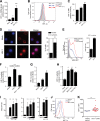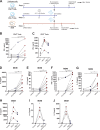Induction of HIF-1α by HIV-1 Infection in CD4+ T Cells Promotes Viral Replication and Drives Extracellular Vesicle-Mediated Inflammation
- PMID: 30206166
- PMCID: PMC6134101
- DOI: 10.1128/mBio.00757-18
Induction of HIF-1α by HIV-1 Infection in CD4+ T Cells Promotes Viral Replication and Drives Extracellular Vesicle-Mediated Inflammation
Abstract
Chronic immune activation and inflammation are hallmarks of HIV-1 infection and a major cause of serious non-AIDS events in HIV-1-infected individuals on antiretroviral treatment (ART). Herein, we show that cytosolic double-stranded DNA (dsDNA) generated in infected CD4+ T cells during the HIV-1 replication cycle promotes the mitochondrial reactive oxygen species (ROS)-dependent stabilization of the transcription factor hypoxia-inducible factor 1α (HIF-1α), which in turn, enhances viral replication. Furthermore, we show that induction of HIF-1α promotes the release of extracellular vesicles (EVs). These EVs foster inflammation by inducing the secretion of gamma interferon by bystander CD4+ T cells and secretion of interleukin 6 (IL-6) and IL-1β by bystander macrophages through an HIF-1α-dependent pathway. Remarkably, EVs obtained from plasma samples from HIV-1-infected individuals also induced HIF-1α activity and inflammation. Overall, this study demonstrates that HIF-1α plays a crucial role in HIV-1 pathogenesis by promoting viral replication and the release of EVs that orchestrate lymphocyte- and macrophage-mediated inflammatory responses.IMPORTANCE Human immunodeficiency virus type 1 (HIV-1) is a very important global pathogen that preferentially targets CD4+ T cells and causes acquired immunodeficiency syndrome (AIDS) if left untreated. Although antiretroviral treatment efficiently suppresses viremia, markers of immune activation and inflammation remain higher in HIV-1-infected patients than in uninfected individuals. The hypoxia-inducible factor 1α (HIF-1α) is a transcription factor that plays a fundamental role in coordinating cellular metabolism and function. Here we show that HIV-1 infection induces HIF-1α activity and that this transcription factor upholds HIV-1 replication. Moreover, we demonstrate that HIF-1α plays a key role in HIV-1-associated inflammation by promoting the release of extracellular vesicles which, in turn, trigger the secretion of inflammatory mediators by noninfected bystander lymphocytes and macrophages. In summary, we identify that the coordinated actions of HIF-1α and extracellular vesicles promote viral replication and inflammation, thus contributing to HIV-1 pathogenesis.
Keywords: CD4+ T lymphocyte; extracellular vesicles; human immunodeficiency virus; hypoxia-inducible factor 1 alpha; inflammation; macrophage.
Copyright © 2018 Duette et al.
Figures








Similar articles
-
A Dynamic Interplay of Circulating Extracellular Vesicles and Galectin-1 Reprograms Viral Latency during HIV-1 Infection.mBio. 2022 Aug 30;13(4):e0061122. doi: 10.1128/mbio.00611-22. Epub 2022 Aug 9. mBio. 2022. PMID: 35943163 Free PMC article.
-
STING regulates metabolic reprogramming in macrophages via HIF-1α during Brucella infection.PLoS Pathog. 2021 May 14;17(5):e1009597. doi: 10.1371/journal.ppat.1009597. eCollection 2021 May. PLoS Pathog. 2021. PMID: 33989349 Free PMC article.
-
Nitrite-derived nitric oxide reduces hypoxia-inducible factor 1α-mediated extracellular vesicle production by endothelial cells.Nitric Oxide. 2017 Feb 28;63:1-12. doi: 10.1016/j.niox.2016.12.005. Epub 2016 Dec 23. Nitric Oxide. 2017. PMID: 28017872
-
HIF-1α induction, proliferation and glycolysis of Theileria-infected leukocytes.Cell Microbiol. 2015 Apr;17(4):467-72. doi: 10.1111/cmi.12421. Epub 2015 Feb 26. Cell Microbiol. 2015. PMID: 25620534 Review.
-
HIV Persistence in Adipose Tissue Reservoirs.Curr HIV/AIDS Rep. 2018 Feb;15(1):60-71. doi: 10.1007/s11904-018-0378-z. Curr HIV/AIDS Rep. 2018. PMID: 29423731 Free PMC article. Review.
Cited by
-
Age-Related Gene Alteration in Naïve and Memory T cells Using Precise Age-Tracking Model.Front Cell Dev Biol. 2021 Feb 11;8:624380. doi: 10.3389/fcell.2020.624380. eCollection 2020. Front Cell Dev Biol. 2021. PMID: 33644036 Free PMC article.
-
HIV-1 Tat-mediated astrocytic amyloidosis involves the HIF-1α/lncRNA BACE1-AS axis.PLoS Biol. 2020 May 26;18(5):e3000660. doi: 10.1371/journal.pbio.3000660. eCollection 2020 May. PLoS Biol. 2020. PMID: 32453744 Free PMC article.
-
SARS-CoV-2 Infection in the Central and Peripheral Nervous System-Associated Morbidities and Their Potential Mechanism.Mol Neurobiol. 2021 Jun;58(6):2465-2480. doi: 10.1007/s12035-020-02245-1. Epub 2021 Jan 13. Mol Neurobiol. 2021. PMID: 33439437 Free PMC article. Review.
-
High glucose/ChREBP-induced Hif-1α transcriptional activation in CD4+ T cells reduces the risk of diabetic kidney disease by inhibiting the Th1 response.Diabetologia. 2025 May;68(5):1044-1056. doi: 10.1007/s00125-024-06354-7. Epub 2025 Jan 30. Diabetologia. 2025. PMID: 39885014 Free PMC article.
-
HIV coinfection exacerbates HBV-induced liver fibrogenesis through a HIF-1α- and TGF-β1-dependent pathway.J Hepatol. 2024 Jun;80(6):868-881. doi: 10.1016/j.jhep.2024.01.026. Epub 2024 Feb 2. J Hepatol. 2024. PMID: 38311121 Free PMC article.
References
-
- Veazey RS, DeMaria M, Chalifoux LV, Shvetz DE, Pauley DR, Knight HL, Rosenzweig M, Johnson RP, Desrosiers RC, Lackner AA. 1998. Gastrointestinal tract as a major site of CD4+ T cell depletion and viral replication in SIV infection. Science 280:427–431. doi:10.1126/science.280.5362.427. - DOI - PubMed
-
- Deeks SG, Gange SJ, Kitahata MM, Saag MS, Justice AC, Hogg RS, Eron JJ, Brooks JT, Rourke SB, Gill MJ, Bosch RJ, Benson CA, Collier AC, Martin JN, Klein MB, Jacobson LP, Rodriguez B, Sterling TR, Kirk GD, Napravnik S, Rachlis AR, Calzavara LM, Horberg MA, Silverberg MJ, Gebo KA, Kushel MB, Goedert JJ, McKaig RG, Moore RD. 2009. Trends in multidrug treatment failure and subsequent mortality among antiretroviral therapy-experienced patients with HIV infection in North America. Clin Infect Dis 49:1582–1590. doi:10.1086/644768. - DOI - PMC - PubMed
-
- Duffau P, Wittkop L, Lazaro E, le Marec F, Cognet C, Blanco P, Moreau JF, Dauchy FA, Cazanave C, Vandenhende MA, Bonnet F, Thiebaut R, Pellegrin I, ANRS CO3 Aquitaine Cohort Study Group . 2015. Association of immune-activation and senescence markers with non-AIDS-defining comorbidities in HIV-suppressed patients. AIDS 29:2099–2108. doi:10.1097/QAD.0000000000000807. - DOI - PubMed
-
- Kuller LH, Tracy R, Belloso W, De Wit S, Drummond F, Lane HC, Ledergerber B, Lundgren J, Neuhaus J, Nixon D, Paton NI, Neaton JD, INSIGHT SMART Study Group . 2008. Inflammatory and coagulation biomarkers and mortality in patients with HIV infection. PLoS Med 5:e203. doi:10.1371/journal.pmed.0050203. - DOI - PMC - PubMed
Publication types
MeSH terms
Substances
Grants and funding
LinkOut - more resources
Full Text Sources
Other Literature Sources
Research Materials

